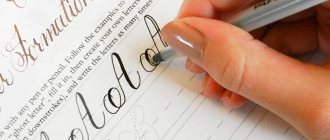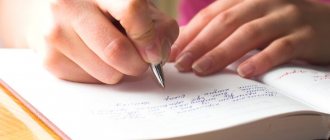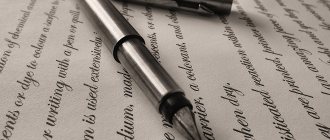Each person’s handwriting is a revelation of the inner essence of our souls. This is not external, factual data, but a state of the hidden unconscious. So, if a man who is outwardly feminine, or even has a non-standard orientation, will write in “feminine” handwriting, and a woman who has developed masculine traits in herself will reveal her essence in the form of a masculine, rough handwriting.
If we exclude such variations in the development of events, there are still some differences and traceable patterns in both male and female handwriting. These differences are dictated primarily by features in the field of psychology. These patterns in handwriting can be traced to genetic factors, social attitudes, upbringing and evolutionary heritage.
Choosing a man based on his handwriting: how to avoid mistakes
Choosing a man based on his handwriting: how to avoid mistakes or “show me what you write and I’ll tell you who you are...”
Women, even with bitter experience in personal relationships and a realistic outlook on life, are often very trusting.
Especially when it comes to romantic impulses and the desire to start a family. And how often we make mistakes about our chosen one!
We close our eyes to the “alarm bells”, ignore the opinions of others and hope: we will be together, and HE will become better.
But people change rarely or not at all . And how we regret later that we knew nothing in advance about the character of a seemingly close person.
Although one could find out about the advantages and disadvantages by looking at the lines scribbled by the hand of a loved one.
Causes of incorrect and ugly handwriting
The main reason why children and adults write illegibly or not beautifully is the need, in principle, to write a lot and quickly.
One has only to remember the handwriting of doctors, which is included, if not in a parable, then certainly in many anecdotes. But this problem is known not only to doctors. Even at school, children are faced with the need to quickly write down information, but little attention is paid to the quality of writing. We learn to write beautifully and hold a pen correctly only in the first grade, but after a while the need to quickly record lectures reduces all efforts to the well-known “chicken paw”.
In the pre-revolutionary era, the speed of writing was limited by fountain pens - schoolchildren and adults had to write letters slowly and carefully so as not to make a blot. With the use of ballpoint pens, such restrictions disappeared. Writing became easier, but this did not have the best effect on the beauty of handwriting.
Personal characteristics also influence the purity of writing letters. For example, it is difficult for a choleric child with a violent, explosive temperament to perfect calligraphy, paying attention to every little detail. He needs additional motivation to carefully write the lines over and over again.
This is interesting
Graphological examination, one of the research methods in criminology, allows one to determine from handwriting not only a person’s temperament, but also his gender, age, and mental state at the time of writing. The size of the letters, the force of pressure, and the sweep of the handwriting are analyzed. Some companies use such expertise for personnel selection.
A man with clear, legible handwriting
You can be confident in this chosen one and your future happy family if the handwriting is with strong pressure, the letters are rounded, there is a distance between them and he writes with a slant to the right.
If there are at least two of these three signs, this is very good.
All this speaks of his friendliness, sociability, determination and generosity. He stands firmly on his feet, happy with the world around him and with himself.
He is open to feelings and does not hide his thoughts. He is attentive to others and can sympathize with other people's troubles. With such a man, as a rule, a strong relationship is established.
The readiness to make compromises in home life is indicated by the small distance left between words.
You should be wary if:
Pressure analysis
Strong pressure is characteristic of self-confident people: Pixabay
Strong pressure distinguishes people who are self-confident, have ebullient energy and high performance, says Elena Isaeva, author of the book “Practical graphology: how to recognize a person’s character by handwriting.” Such individuals are always in the center of attention, as they are sociable, optimistic and have a goal in life. They inspire.
Light pressure is a sign of romantic and sensitive natures who dream of the impossible. They are more focused on the internal world than the external world. They can be entrusted with responsible work, but they cannot be rushed. Accuracy and the desire to avoid mistakes distinguish people with such pressure. Unfortunately, among them there are no people with strong character.
Thanks to handwriting analysis, you can easily understand a person’s character and even determine whether he has a mental disorder. Once you've learned the basics of writing, use this knowledge to connect with people and better understand yourself.
Original article: https://www.nur.kz/esoterics/interesting/1853170-harakter-po-pocerku-kak-opredelit/
Curls in a man's handwriting
Beautiful handwriting is a clear advantage, but... if the ornate handwriting is aggravated by weak pressure, then the woman next to you should prepare for the role of an eternally admiring fan.
The owner of such handwriting thinks only about himself, lives by his own emotions and feelings.
The woman or wife next to him interests him only from the point of view of a grateful listener and creator of psychological comfort.
He is not capable of giving, but at the same time he demands constant admiration for himself.
Should you make a decisive choice based on a man’s handwriting?
Of course, this is not all that can be said about a man’s character from his handwriting. And all of the above is not an axiom.
After all, if you feel comfortable next to a person, then is it so important how he writes?
However, when doubting your own choice and making an important decision, take a closer look: how does your chosen one write?
The meaning of margins and indents
Forensic scientists use handwriting examination to identify a criminal, and psychologists use it to analyze personality. Kurt and Anna Bartol write about this in the book “Modern Perspectives on Forensic Psychology and Criminal Behavior.”
Indents from the edges of the sheet are important in determining a person’s character:
- If there are wide margins on the left, then the person is characterized by a breadth of soul. The person is active and does not like monotony.
- Narrow margins on the left are a sign of pedantry, frugality, and nepotism. Such people make good spouses.
- If the fields expand downward, then the person is thrifty and likes to save. However, this does not mean that he does not like to share. Such a person generously gifts loved ones.
- The widest indentation on the left is extravagance, boastfulness, desire for luxury, pride and familiarity.
- The left edge tapers downwards - self-control, secrecy, stinginess and selfishness.
- If a person leaves wide margins on the right, does not break words, but starts on a new line, then he is very cautious, secretive and even cowardly.
- A large distance between words means a desire to stay at a safe distance from people.
Maximalists leave no margins at all; they love to express themselves, attracting people's attention. Such people strive to live according to the laws of conscience and honor and achieve success.
Graphology
Not as young as it seems at first glance, the science of graphology will tell you what handwriting says about a person’s character. She is engaged in a detailed study of the inclination of letters, the distance between them, as well as their location on paper. The analysis reveals not only personal qualities, but also future prospects or inclinations.
In fact, the connection between handwriting and a person’s character was noticed back in the Middle Ages. The basis of graphology is considered to be a book written by the Roman historian Suetonius back in the 16th century. And after a couple of centuries, data on handwriting was systematized by Michon. The final proof of this connection was the experiments conducted by V. Preyer using hypnosis - he inspired the same person that he had different character traits, and the subject’s handwriting changed radically.
How to learn to write letters beautifully
It is not for nothing that calligraphy is considered one of the art forms. The symmetry and clarity of the lines make it similar to graphics. But what’s nice is that you don’t need talent to master this art—everyone who shows patience can do it. It’s worth starting with the basics: practice holding a pen correctly, get used to sitting at the table correctly, practice writing lines and curls, just like in elementary school. Therefore, there are no simple tips on how to learn to write beautifully in 5 minutes: it takes time to improve your handwriting.
This is interesting
Doctor of Biological Sciences Sergei Savelyev in his lecture “Calligraphy and the Brain” states that penmanship has a positive effect on the rate of maturation and differentiation of neurons. In other words, it is a unique tool for brain development in children and adults - no worse than intellectual games (for example, chess).
Correct fit
Before writing letters, choose a well-lit study area, a table and a chair of the right height. To properly adjust the height of your chair, sit on it and pay attention to the following:
- the tabletop should be located approximately at stomach level;
- if you put your elbows on the table, they should be bent at an angle of 90°;
- the angle at the knees, provided that the feet are completely on the floor, should also be 90°.
When sitting on a chair, do not touch the tabletop - there should be a distance between it and your body. Remember that the back of a chair can and should be used as a back support.
For many, this position seems uncomfortable at first, but this is only because the muscles have become unaccustomed to the correct body position. It may be worth purchasing a table with an inclined surface for studying (this is what classrooms for first-graders are often equipped with) - it will help avoid neck strain.
Holding the pen correctly
It turns out that not everyone even knows how to hold a ballpoint pen correctly. But this skill is also very important to improve your handwriting and learn to write beautifully. Calligraphy with a ballpoint pen begins with practicing the correct grip:
- hold the pen between your thumb and index finger, with your middle finger serving as support;
- make sure that you do not grab it too close to the shaft - there should be about ⅓ of the length left to the tip;
- Let the upper part of the handle be at the base of the thumb and rest on the hollow between it and the index finger.
For training, choose ballpoint or gel pens of moderate or slightly increased thickness. It would be great if there is a rubber pad on the handle. Children's fish pads help develop the correct grip.
One of the most common writing mistakes is a high wrist, which causes unnecessary tension in the hand. Normally, the wrist is lifted off the table or sheet of paper by only a few millimeters.
Uppercase notebook
Those who want to radically improve their handwriting need to go back to the basics - buy or download a few copybooks and re-develop their graphic skills.
For example, children's copybooks for preschoolers and first-graders will help them learn how to beautifully connect letters, practice slanting, loops and curves. They provide standards for writing letters and numbers, but this, of course, is not enough for calligraphy classes.
There are copybooks for adults - they will help those who want not only to learn how to write beautifully with a pen, but also to acquire their own style. By trying different fonts and repeating certain elements over and over again, you can overcome old muscular habits and develop new ones - those that lead to beautiful handwriting.
Finally, there are separate copybooks for calligraphy. Such materials will help you master interesting strokes, curls, and original writing of capital letters. Among them you can find both paper and electronic books with training inserts. For example, “Copybooks for Calligraphy” by Victoria and Vitalina Lopukhin or “Calligraphy” by Ilya Bogdesko.
To practice new writing skills, at first it is better to use a squared notebook and write out letters in each cell - it’s more convenient. To correct the inclination of letters, children's notebooks with a small oblique line are well suited.
Tips for improving handwriting and a review of the copybook generator
Special exercises
In addition to copybooks, special exercises that develop fine motor skills can help in the fight for beautiful handwriting. Some of them are familiar to us from childhood, but this does not mean that they are suitable only for preschoolers - adults will also find them useful.
Useful exercises:
- Drawing letters and numbers in the air. Choose a font that is unfamiliar to you or take the writing of letters in copybook as a sample and try to repeat it several times in the air. When it becomes easy, transfer everything to paper.
- Writing with an ink pen. Do your usual copywriting practice using ink rather than a ballpoint pen. This is the easiest way to learn how to write beautifully; it is often used in calligraphy classes for beginners, because you can’t rush it - it will take time and accuracy.
- Point figures. A funny and seemingly simple, but very useful fine motor skills trainer. You can print it from the Internet and move from the simplest to the more voluminous, with a large number of lines and dots.
General organization of handwriting
When analyzing, the first thing to check is the evenness of the handwriting. This determines from which side (positive/negative) this or that personality trait will be viewed:
- Smooth and perfectly organized handwriting shows an active and focused person who is always confident in his own abilities and does not have a tendency to frequent failures.
- Large, but not entirely organized handwriting indicates impulsiveness.
- Small and organized indicates that its owner uses his own strength wisely.
- Indecisive and timid people show small and very poorly organized handwriting - this is an insecure person who retreats at the first difficulties.
Large or small handwriting will tell about a person’s relationship with the people around him. Many people want to know what the small size of letters says about a person, because statistics show that the number of individuals with small handwriting slightly exceeds the number of people accustomed to large letters.
To begin with, you should mark the boundaries - letters that reach 3 millimeters in height are considered average. Accordingly, small ones are up to 3 mm, and large ones are from 3 mm.
- Owners of large handwriting are always sociable and active, they can support any conversation and cheer up the most boring company.
- Too small letters indicate modesty and reluctance to attract attention. Although it should be noted that people who write in small handwriting love to think, it is difficult to expect bold actions from them.
- And medium-sized letters go to people who always know how to find compromises. They realistically assess their strengths and can adapt to any situation.
Interpreting handwriting correctly: life hacks from graphologists
Photo: TASS/YAY
In order for the graphological analysis to be complete, experts recommend adhering to the following conditions when writing text:
- The manuscript must be written on a blank, unlined sheet of A4 format;
- Be sure to write with a blue ballpoint pen on a flat surface; you need to place at least three more sheets of paper under the paper - this will make it possible to take into account such a characteristic as pressure;
- The text should be free: when rewriting ready-made phrases or quoting, a person will have more control over himself. For graphological analysis, freedom of writing is important, more clearly reflecting internal and unconscious processes;
- A couple of phrases are not enough for a full analysis. Ideally, at least two or three A4 sheets should be written on;
- It is advisable for the specialist to have handwriting samples from different periods of time. This will allow us to take into account the dynamics of personality development and separate permanent factors (mood, poor health) from unchanged personal characteristics.
Autograph of a person with a mental disorder.
Photo: illustration from Dmitry Zuev-Insarov’s book “Handwriting and Personality”
After a correctly completed sample has been received, you can proceed directly to interpreting what was written. Conventionally, we can identify several basic characteristics of handwriting that need to be taken into account when analyzing it:
- Shape/height/width: can tell about a person’s relationship with the internal and external worlds;
- Pressure: shows the degree of energy of a person;
- Movement, writing fluency: speaks about the speed of mental processes;
- Continuity: indicates a sequence of actions;
- Slope: speaks of the movement of emotions;
- Homogeneity: constancy/inconsistency of personal qualities;
- Line formations: will help in drawing up a psychological portrait;
- Use of space on paper: gravitation towards the past/future, conscious/unconscious;
- Line shapes: can say a lot about a person's temperament.
As examples, graphologist Sergei Sergeev cited rounded handwriting (arc elements of forms - openness, cheerfulness, emotions, feelings), large handwriting (extroversion, thoroughness, self-confidence), small handwriting (introversion, fatigue), fast writing speed, which speaks of a person’s flexibility, and slow speed, which may indicate a stubborn nature.
Handwriting of Alexander Pushkin.
Photo: illustration from Dmitry Zuev-Insarov’s book “Handwriting and Personality”
An interesting example would be the natural calligraphic handwriting of an adult who writes this way all the time (important: moments when people deliberately try to write beautifully, for example, when making cards or filling out documents, do not count). According to graphologists, a regular desire for stylization may indicate excessive concentration on form rather than content. As Sergeev noted, if a person writes in a stylized manner all the time, he can be secretive and constantly keep himself within limits, trying to demonstrate to those around him that everything in his life is perfect.
Lines and strings
No less important are the lines and lines that characterize a person’s reaction to various external stimuli (surrounding events). The person’s subconscious plays a role here, since the line for writing a word is chosen not at the physical level, but precisely at the subconscious:
- Smooth lines are observed by a reliable person who will always fulfill a friend’s request and will not let you down in difficult situations.
- Pretentiously straight lines indicate too many knowledge control questions.
- Uneven lines are observed in those who lack strong internal stability.
- An upward directed line indicates optimism, and a downward directed line indicates a pessimistic owner.
Certain distances between lines and words give characteristics about the behavior and thinking of an individual.
People who are constantly confused prefer to have small spacing between lines. Handwriting that speaks of a person who is attentive and makes informed decisions is the large spaces between the lines.
The volume of mental and physical space is shown by the intervals between words:
- A person who is able to adequately perceive the external picture and respect social inequality has the same spaces between words.
- Distances of different sizes indicate a fickle personality who communicates only with people he likes, and simply ignores the rest.
- Narrow spaces characterize a closed person who allows others to get close to him. Such a person does not require too much personal space, but prefers to be more close to other people.
- Large spaces between words reveal the owner's fear of contact with others. It will be very difficult to make acquaintance with such a person, but when approaching him, he will seem to be a rather interesting interlocutor.
Orientation in space
If the written lines have a clear horizontal orientation, then the person knows how to concentrate on the main thing. He has a balanced character, it is difficult to unsettle him, and he himself will not create a problem out of a trifle.
If the end of the line tends upward (flies up), this indicates optimism, cheerfulness, a cheerful and mischievous nature.
Lines that constantly slide down are a sign of a pessimist. Such a person criticizes, looks at life coldly and cynically. He has a heavy sense of humor and a habit of complaining about life.
If the lines dance up and down, then the person is fickle. It is difficult for him to adapt to new living conditions, his mood is constantly changing.
Slant letters
The characteristics of handwriting tell about the level of emotional reactions, as well as the degree of understanding of others.
- The strict verticality of the letters hides a calm and calm person, who is often indifferent to others at a time when others experience completely different feelings.
- If the letters are slightly tilted to the right, then this is direct evidence of a soft reaction to the environment. Such a person cannot be called restrained, since before showing emotions, he first thinks everything over carefully.
- An increased tilt to the right shows emotional tension and impulsiveness.
- Cold people tilt their letters to the left when writing. They protect themselves from irritants as much as possible and often act selfishly towards others.
How employees are selected
In some European countries, personnel are selected according to clear rules, one of which is a graphological examination - this will be the last step in the test. The final decision to accept an employee for a position is made only after the boss knows exactly what the person’s handwriting says (there are examples below).
Only worthy people are hired for financial positions in the United States. They have to take quite difficult tests, where handwriting plays an important role. A graphologist can make a verdict that a person is prone to deception, and then he will be refused.
Passing the examination is not always easy. For example, people whose hallmark is clumsy handwriting, which indicates a person prone to quarrels and fickleness, are unlikely to obtain a prestigious position in many countries.
An initiative and creative person is usually considered for the position of director. But in order to take this place, you must have the right handwriting: the letters must be wide and of different sizes, and the presence of the correct relationship between curves and corners is also necessary. In addition, the required handwriting feature for the position of director is a straight or slightly raised line.
Graphotherapy
Graphotherapy is based on calculating all the shortcomings, bad habits and some character traits that a person wants to get rid of. Forewarned is forearmed, right? It is much easier to get rid of shortcomings when you know what exactly you need to get rid of. Graphologists monitor a person’s changes to the last, because it often happens that after getting rid of one character trait, another, even worse than the previous one, appears.
Every change in our character is immediately reflected in our handwriting, so do not be surprised that it will change more than once, or even twice, throughout our lives.
Head of Public Relations
A cool and courageous person is ideal for this position, but the ability to communicate with people in writing must also be present. The handwriting of a public relations manager should be as clear as possible and have its own characteristics: fast pace of writing, wide handwriting, letters connected to each other. Most often, the signature of such a person ends with a small stroke.
An employee in the financial sector must be able to concentrate quickly and have a stable psyche. This is what handwriting that is easy to read says about a person. Letters should be large in size, and the distance between words should be as large as possible.
A person who dreams of working as an engineer must have a lively mind and quick reactions. The handwriting of such a person is distinguished by rounded letters, where there are some angularities. The spacing between words and lines is quite large, and the letters themselves are not too narrow.











